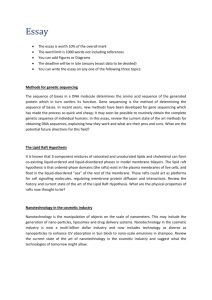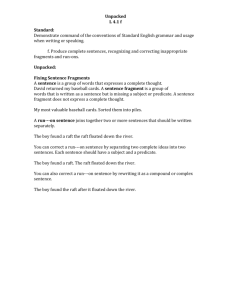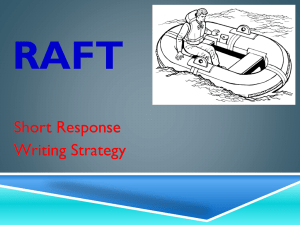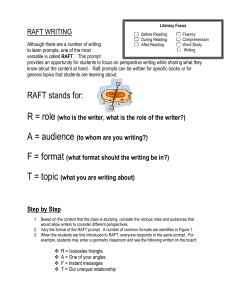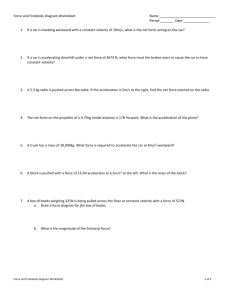Stretched Bungee Cords are Like Electrical Potential Energy
advertisement
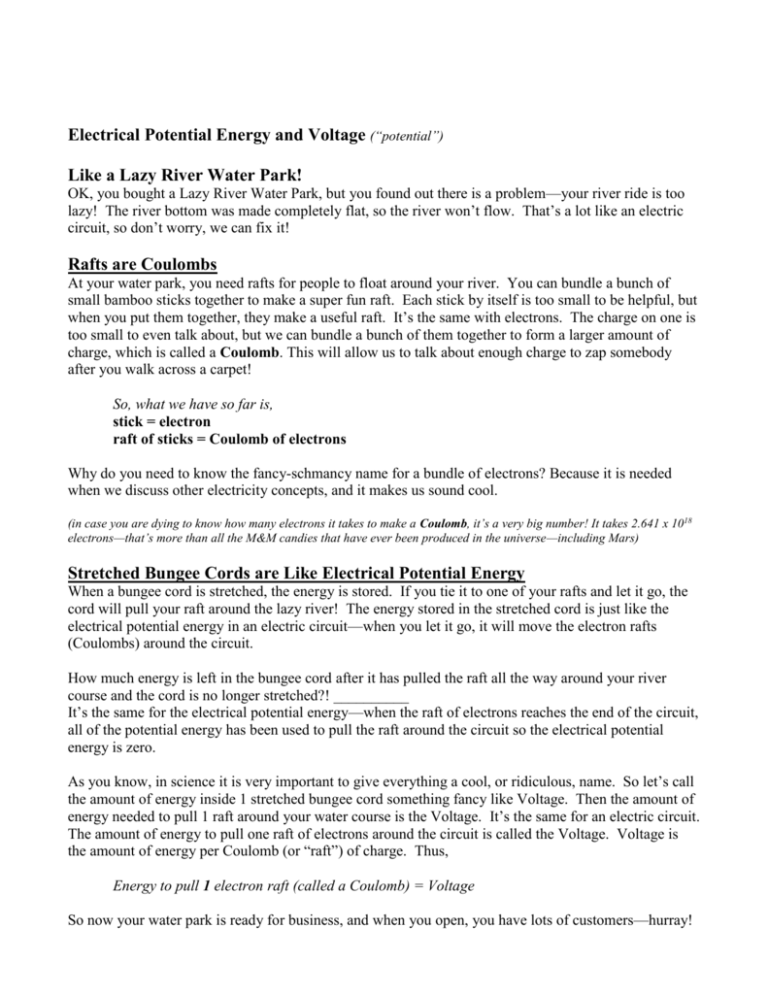
Electrical Potential Energy and Voltage (“potential”) Like a Lazy River Water Park! OK, you bought a Lazy River Water Park, but you found out there is a problem—your river ride is too lazy! The river bottom was made completely flat, so the river won’t flow. That’s a lot like an electric circuit, so don’t worry, we can fix it! Rafts are Coulombs At your water park, you need rafts for people to float around your river. You can bundle a bunch of small bamboo sticks together to make a super fun raft. Each stick by itself is too small to be helpful, but when you put them together, they make a useful raft. It’s the same with electrons. The charge on one is too small to even talk about, but we can bundle a bunch of them together to form a larger amount of charge, which is called a Coulomb. This will allow us to talk about enough charge to zap somebody after you walk across a carpet! So, what we have so far is, stick = electron raft of sticks = Coulomb of electrons Why do you need to know the fancy-schmancy name for a bundle of electrons? Because it is needed when we discuss other electricity concepts, and it makes us sound cool. (in case you are dying to know how many electrons it takes to make a Coulomb, it’s a very big number! It takes 2.641 x 1018 electrons—that’s more than all the M&M candies that have ever been produced in the universe—including Mars) Stretched Bungee Cords are Like Electrical Potential Energy When a bungee cord is stretched, the energy is stored. If you tie it to one of your rafts and let it go, the cord will pull your raft around the lazy river! The energy stored in the stretched cord is just like the electrical potential energy in an electric circuit—when you let it go, it will move the electron rafts (Coulombs) around the circuit. How much energy is left in the bungee cord after it has pulled the raft all the way around your river course and the cord is no longer stretched?! __________ It’s the same for the electrical potential energy—when the raft of electrons reaches the end of the circuit, all of the potential energy has been used to pull the raft around the circuit so the electrical potential energy is zero. As you know, in science it is very important to give everything a cool, or ridiculous, name. So let’s call the amount of energy inside 1 stretched bungee cord something fancy like Voltage. Then the amount of energy needed to pull 1 raft around your water course is the Voltage. It’s the same for an electric circuit. The amount of energy to pull one raft of electrons around the circuit is called the Voltage. Voltage is the amount of energy per Coulomb (or “raft”) of charge. Thus, Energy to pull 1 electron raft (called a Coulomb) = Voltage So now your water park is ready for business, and when you open, you have lots of customers—hurray! But now you will need more than 1 bungee worth of stored energy. You will need to pull lots of rafts around the river, so you will need a lot of stretched (stored) bungee energy. This is the same for an electric circuit. Your iphone needs to use lots of stored (potential) electrical energy to pull lots of electron rafts so you can text during class. Total energy to pull all the electron rafts = electrical potential energy Solve Some Problems Let’s say we know the amount of energy needed to pull 1 raft (“the voltage”) is 1 “glob” of energy/raft. Then the voltage is 1 “glob”/raft. If you have 10 customers, the potential energy you need to pull 10 rafts is 10 “globs” of energy. If you have 25 customers, the potential energy you need to pull 25 rafts is 25 “globs” of energy. Now, instead of “globs”, let’s state the voltage as 1 joule of energy/raft. Then the potential energy you need to pull 25 rafts is 25 joules of energy. If rafts start to get in each others way, it might require more bungee energy to pull them through. So you might have to increase the stretch of the bungee to 3 joules/raft. Then 25 rafts would require 75 joules of potential energy to complete the course. Get it?! The battery in a circuit is like the bungee cord stretcher, and provides the potential energy Summary Voltage is the amount of energy to pull 1 raft of electrons around the circuit Electrical Potential Energy is the total amount of energy for all the electron rafts Your Turn (fill in the blanks) If you have 6 customers, and you know your voltage is 4 joules/raft, the potential energy you need to pull the 6 rafts is __________ “joules” of energy? If you have 9 customers, and you know your voltage is 2 joules/raft, the potential energy you need to pull the 9 rafts is __________ “joules” of energy?
